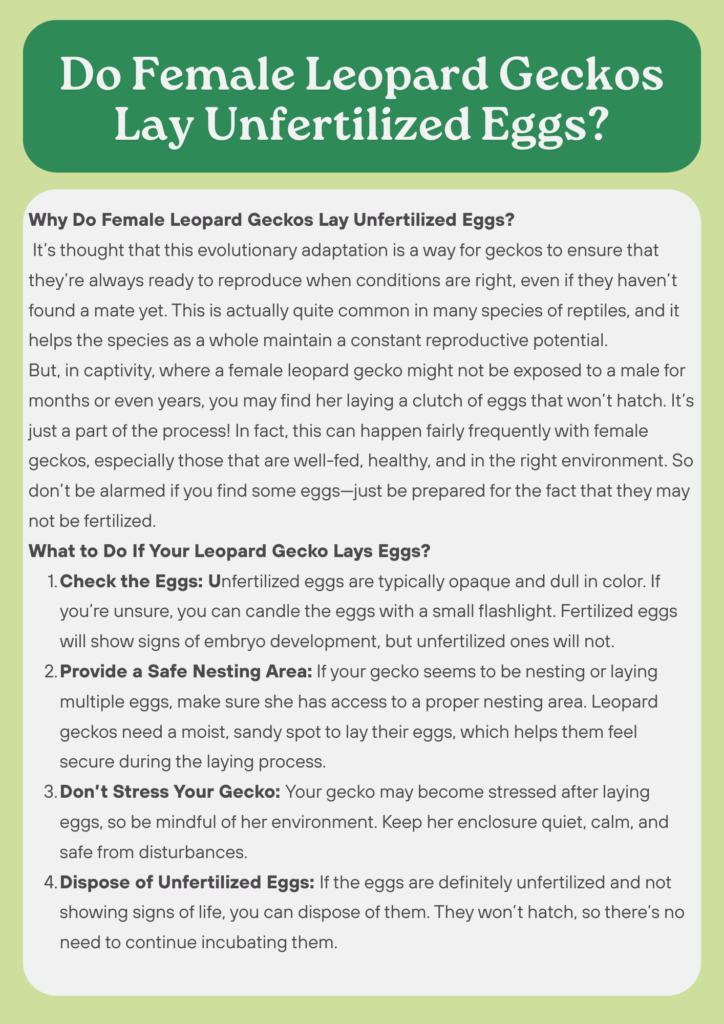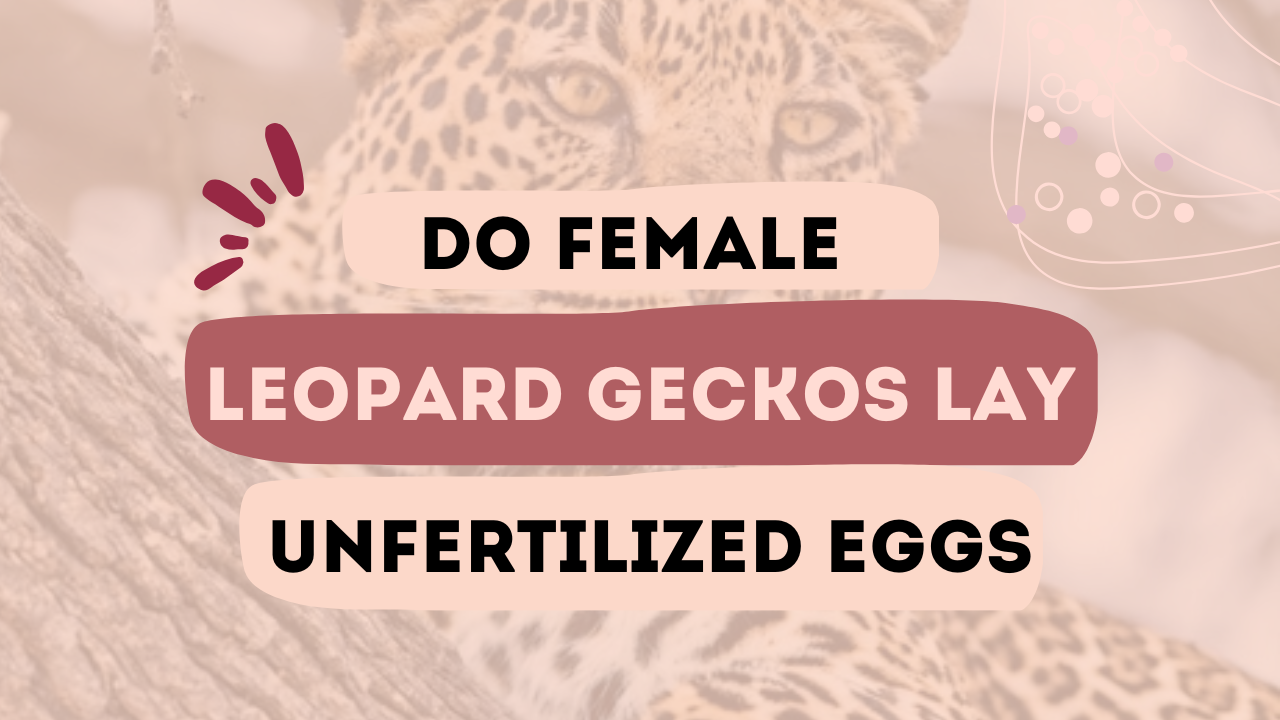Leopard geckos, those adorable little reptiles that have captured the hearts of pet lovers around the world, are full of surprises when it comes to their reproduction habits.
One common question that many new gecko owners find themselves asking is, “Do female leopard geckos lay unfertilized eggs?” It’s an interesting topic, and one that can be a bit confusing for first-time owners.
After all, reptiles aren’t exactly like mammals, and their reproductive processes can be very different. So, if you’ve been wondering about the possibility of your female leopard gecko laying eggs without a mate, you’re not alone.
Let’s dive into the fascinating world of leopard gecko reproduction and shed some light on this question.
Understanding Leopard Gecko Reproduction
To really get the answer to whether female leopard geckos lay unfertilized eggs, it’s essential to first understand a little about how leopard geckos reproduce. Unlike mammals, reptiles like geckos don’t need to mate every time a female is ready to lay eggs. Female leopard geckos can actually produce eggs even if they have never been in contact with a male.
This happens because female geckos have developed the ability to produce eggs independently, a process known as parthenogenesis. But here’s the catch—while they may produce the eggs, they won’t always be fertile. So, yes, it’s entirely possible for your female gecko to lay eggs that are, well, unfertilized. This doesn’t necessarily mean there’s something wrong with her. It’s just the way her biology works.
What Causes Unfertilized Eggs?
Now, you might be wondering, “Okay, so what causes female leopard geckos to lay unfertilized eggs if they don’t even need a male?” Great question! The key here lies in their reproductive cycle. Female leopard geckos, much like many other reptiles, go through an internal process where their bodies prepare to produce eggs. These eggs are laid in a clutch (a group of eggs), and a gecko can lay anywhere from one to a few eggs in a single clutch.
Even without mating, the female’s body will still go through the motions of creating eggs. However, since there’s no male around to fertilize them, they remain infertile. It’s just part of the natural reproductive cycle. It’s not necessarily a bad thing either. For instance, female geckos will often lay these eggs regardless of whether a mate is present. It’s kind of like a cat or dog that has a heat cycle but may not always be impregnated.
How Do You Know If the Eggs Are Unfertilized?
If you’re lucky enough to notice that your gecko has laid eggs, you might be wondering how you can tell if they are unfertilized. After all, not all eggs are the same! Unfertilized leopard gecko eggs often appear slightly opaque or dull in color. Fertilized eggs, on the other hand, tend to look more translucent or have a more defined white spot. The white spot is usually a sign of a developing embryo. But if your gecko’s eggs are looking a bit less bright, it’s likely that they are unfertilized.
Another thing to note is that unfertilized eggs usually don’t hatch. If the eggs are incubated under the right conditions, they may still appear viable for a while but eventually, they’ll start to lose their firmness and begin to break down. Unfertilized eggs, when incubated, do not develop into babies, so they can be safely disposed of after a while.

Why Do Female Leopard Geckos Lay Unfertilized Eggs?
Female geckos are kind of fascinating in that they don’t need a mate to lay eggs. But why would a gecko’s body continue this process even if there’s no chance of the eggs hatching? It’s thought that this evolutionary adaptation is a way for geckos to ensure that they’re always ready to reproduce when conditions are right, even if they haven’t found a mate yet. This is actually quite common in many species of reptiles, and it helps the species as a whole maintain a constant reproductive potential.
But, in captivity, where a female leopard gecko might not be exposed to a male for months or even years, you may find her laying a clutch of eggs that won’t hatch. It’s just a part of the process! In fact, this can happen fairly frequently with female geckos, especially those that are well-fed, healthy, and in the right environment. So don’t be alarmed if you find some eggs—just be prepared for the fact that they may not be fertilized.
What to Do If Your Leopard Gecko Lays Eggs?
Okay, so your gecko has laid eggs. Now what? First of all, don’t panic! It’s perfectly normal. If your gecko hasn’t been in contact with a male, you can rest assured that the eggs are most likely unfertilized. You’ll want to handle the situation calmly to ensure your gecko’s wellbeing.
Here are a few things you can do:
- Check the Eggs: As mentioned, unfertilized eggs are typically opaque and dull in color. If you’re unsure, you can candle the eggs with a small flashlight. Fertilized eggs will show signs of embryo development, but unfertilized ones will not.
- Provide a Safe Nesting Area: If your gecko seems to be nesting or laying multiple eggs, make sure she has access to a proper nesting area. Leopard geckos need a moist, sandy spot to lay their eggs, which helps them feel secure during the laying process.
- Don’t Stress Your Gecko: Your gecko may become stressed after laying eggs, so be mindful of her environment. Keep her enclosure quiet, calm, and safe from disturbances.
- Dispose of Unfertilized Eggs: If the eggs are definitely unfertilized and not showing signs of life, you can dispose of them. They won’t hatch, so there’s no need to continue incubating them.
Can Unfertilized Eggs Cause Harm to Your Leopard Gecko?
In most cases, laying unfertilized eggs won’t harm your female leopard gecko. However, there are a few things you should keep an eye on. If a female gecko lays multiple clutches of eggs or if she’s laying eggs frequently, she could become depleted of calcium, which is crucial for her health. Egg-laying can be taxing, so ensure she has access to proper nutrition, particularly calcium supplements, to help her stay healthy.
Additionally, if you notice that she is having difficulty laying the eggs (a condition known as egg-binding), it may require medical attention. This is a rare but serious condition that could be harmful to your gecko, and it requires the help of a reptile vet.
Conclusion
In conclusion, yes, female leopard geckos can and do lay unfertilized eggs, especially if they haven’t mated with a male. It’s just a natural part of their reproductive cycle! Unfertilized eggs won’t hatch, and while they can be an occasional nuisance for pet owners, they generally don’t pose a health risk to the gecko. Just be sure to provide her with the proper care, a safe space for laying eggs, and keep an eye on her overall health. With a little understanding and care, your gecko can continue to thrive, whether or not she’s laying eggs.

